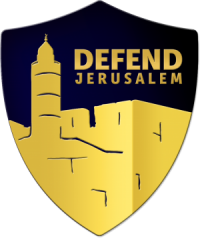Originally published in

By TOI STAFF
14 June 2020, 7:16 pm
Image: Shaina Hirsch in front of the Dome of the Rock on June 10, 2020. (Facebook)
Mohammad Sanjalawy asked to clarify conduct in incident broadcast on Facebook Live, during which he dismissed Jewish connection to flashpoint site
The Israel Police summoned a Waqf security guard after he detained an Israeli woman for asserting that a Jewish temple had once stood on the Temple Mount in a Facebook Live video that she broadcast during a visit to the flashpoint holy site, law enforcement confirmed on Sunday.
The security guard, Mohammad Sanjalawy, was summoned for clarification of his conduct during the Wednesday altercation, a police spokesman said, adding that no additional punitive measures would be taken.
The Israeli woman, Shaina Hirsch, posted a live stream of her visit during which she explained the history of the Temple Mount, the current site of the Al-Aqsa Mosque. After several minutes of talking, she was approached by Sanjalawy, who can be heard telling her that she is “not allowed to talk about [the] temple here. You’re at a mosque.”
“I’m not allowed to say that there was a temple here?” she responded.
“Exactly,” the guard of the Islamic authority that oversees the site said, also claiming that she was also not allowed to livestream her visit.
The two proceeded to argue over whether Jewish temples had once stood at the compound, with Sanjalawy insisting that there “had been a mosque [there] since [the time of] Adam.”
He went on to claim that Zionists “picked a land [around] 1940… and they said, this is the place we’re going to send the Jews because they were killed everywhere.”
Sanjalawy then detained Hirsch for questioning.
“They told me they would release me when I would stop telling lies. But I wasn’t telling lies,” Hirsch wrote in a blog post for The Times of Israel.
“They told me they would release me if I myself could prove that there was anything up there from before a mosque.”
“After some questioning, I was handed off to the Israeli police, who tried to keep a straight face as they told me I did nothing illegal, but that I had to respect the site and I couldn’t say that there had been a [temple] there,” she added.
Located in the heart of Jerusalem’s Old City, the compound is revered by both Jews, as the site of the two Jewish temples, and Muslims, who call is Haram al-Sharif or the Noble Sanctuary, and is a site where large numbers of Palestinians often gather, especially for Friday prayers. It has long been a flashpoint between Israelis and Palestinians.
Under an arrangement in place since Israel’s victory in the 1967 Six Day War, Muslims can enter and pray at the Temple Mount while non-Muslims are allowed to sometimes visit the site but not to pray there. Jews are allowed to enter in small groups during limited hours, but are taken through a predetermined route, are closely watched and are prohibited from worship or displaying any religious or national symbols, as well as various other restrictions.
The Waqf, a Jordanian-appointed council, oversees Muslim holy sites in Jerusalem. It claims exclusive authority over the Temple Mount compound and says it is not subject to Israeli jurisdiction.
